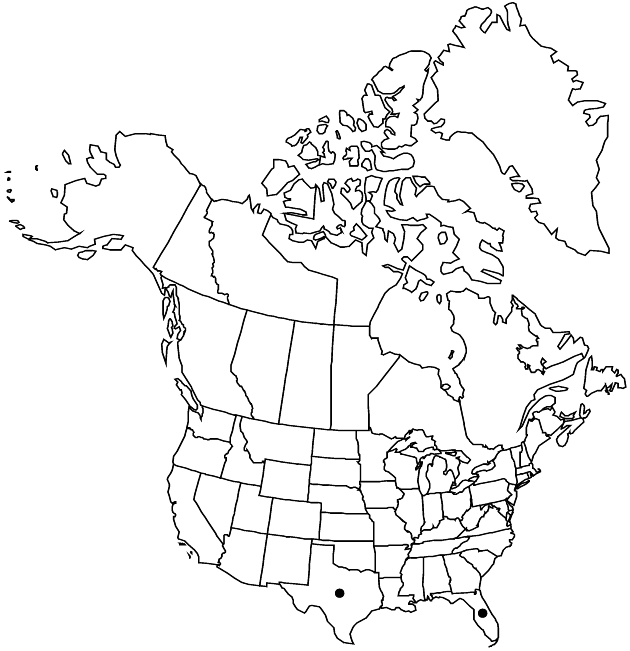Difference between revisions of "Tithonia diversifolia"
Proc. Amer. Acad. Arts 19: 5. 1883.
FNA>Volume Importer |
imported>Volume Importer |
||
| (5 intermediate revisions by 2 users not shown) | |||
| Line 8: | Line 8: | ||
}} | }} | ||
|common_names=Tree marigold;Mexican sunflowerweed | |common_names=Tree marigold;Mexican sunflowerweed | ||
| − | |basionyms={{Treatment/ID/ | + | |special_status={{Treatment/ID/Special_status |
| + | |code=I | ||
| + | |label=Introduced | ||
| + | }} | ||
| + | |basionyms={{Treatment/ID/Basionym | ||
|name=Mirasolia diversifolia | |name=Mirasolia diversifolia | ||
|authority=Hemsley | |authority=Hemsley | ||
| + | |rank=species | ||
| + | |publication_title=Biol. Cent.-Amer., Bot. | ||
| + | |publication_place=2: 168, plate 47. 1881 | ||
}} | }} | ||
|synonyms= | |synonyms= | ||
| Line 27: | Line 34: | ||
|elevation=0–20+ m | |elevation=0–20+ m | ||
|distribution=Fla.;Tex.;Mexico;also introduced in West Indies;Central America;Asia;Africa;Atlantic Islands;Indian Ocean Islands;Pacific Islands;Australia. | |distribution=Fla.;Tex.;Mexico;also introduced in West Indies;Central America;Asia;Africa;Atlantic Islands;Indian Ocean Islands;Pacific Islands;Australia. | ||
| + | |introduced=true | ||
|discussion=<p><i>Tithonia diversifolia</i> is widely cultivated in warm climates and may persist after plantings; a report for Louisiana was not confirmed for this treatment.</p> | |discussion=<p><i>Tithonia diversifolia</i> is widely cultivated in warm climates and may persist after plantings; a report for Louisiana was not confirmed for this treatment.</p> | ||
|tables= | |tables= | ||
| Line 36: | Line 44: | ||
-->{{#Taxon: | -->{{#Taxon: | ||
name=Tithonia diversifolia | name=Tithonia diversifolia | ||
| − | |||
|authority=(Hemsley) A. Gray | |authority=(Hemsley) A. Gray | ||
|rank=species | |rank=species | ||
| Line 51: | Line 58: | ||
|publication title=Proc. Amer. Acad. Arts | |publication title=Proc. Amer. Acad. Arts | ||
|publication year=1883 | |publication year=1883 | ||
| − | |special status= | + | |special status=Introduced |
| − | |source xml=https:// | + | |source xml=https://bitbucket.org/aafc-mbb/fna-data-curation/src/2e0870ddd59836b60bcf96646a41e87ea5a5943a/coarse_grained_fna_xml/V19-20-21/V21_336.xml |
|tribe=Asteraceae tribe Heliantheae | |tribe=Asteraceae tribe Heliantheae | ||
|subtribe=Asteraceae (tribe Heliantheae) subtribe Helianthinae | |subtribe=Asteraceae (tribe Heliantheae) subtribe Helianthinae | ||
Latest revision as of 20:11, 5 November 2020
Perennials, subshrubs, or shrubs, to 250(–500) cm. Leaves: petioles 2–6 cm; blades ± deltate to pentagonal, 7–33 × 7–22 cm, sometimes 3- or 5-lobed, abaxial faces glabrous to hispid-pilose. Peduncles 7–24 cm. Phyllaries 16–28 in (3–)4 series, oblong to ovate; outer 6–10 × 4–7 mm, apices rounded to acute, abaxial faces usually glabrous; inner 10–20 × 3–10 mm, apices rounded to acute, abaxial faces glabrous. Paleae 10–13 × 2–3 mm, mucros 1.5–2.5 mm. Ray florets 7–14; corollas yellow, laminae linear, 48–69 × 9–16 mm. Disc florets 80–120+. Cypselae 4–6 mm. 2n = 34.
Phenology: Flowering Sep–Jan.
Habitat: Disturbed sites
Elevation: 0–20+ m
Distribution

Introduced; Fla., Tex., Mexico, also introduced in West Indies, Central America, Asia, Africa, Atlantic Islands, Indian Ocean Islands, Pacific Islands, Australia.
Discussion
Tithonia diversifolia is widely cultivated in warm climates and may persist after plantings; a report for Louisiana was not confirmed for this treatment.
Selected References
None.